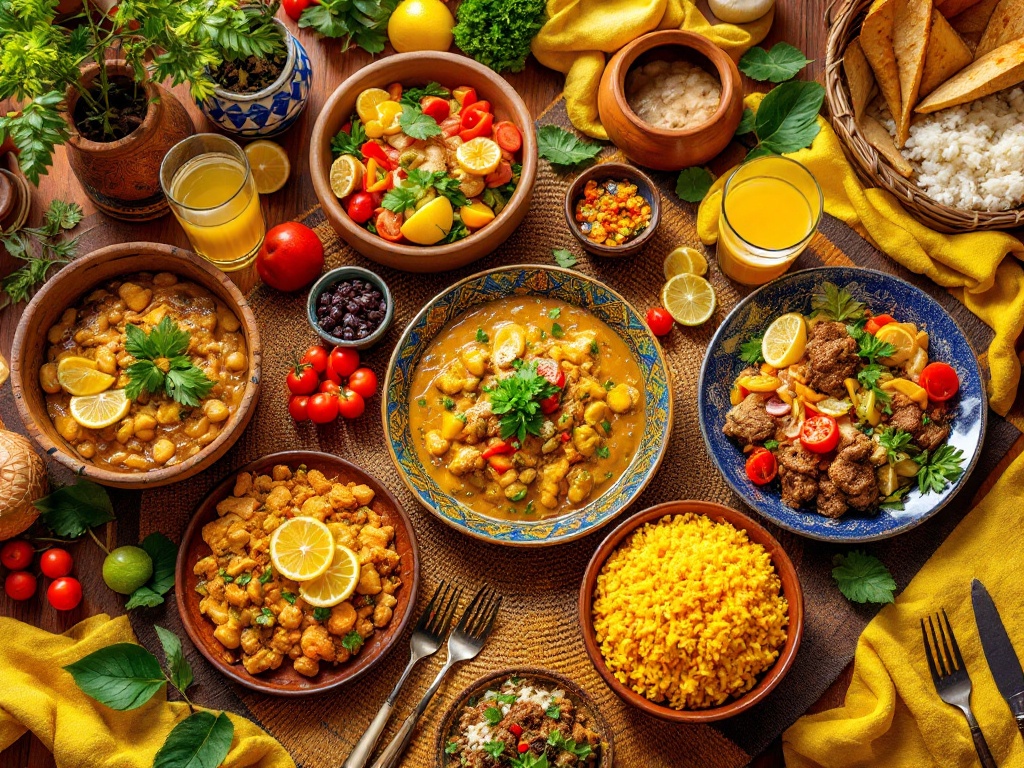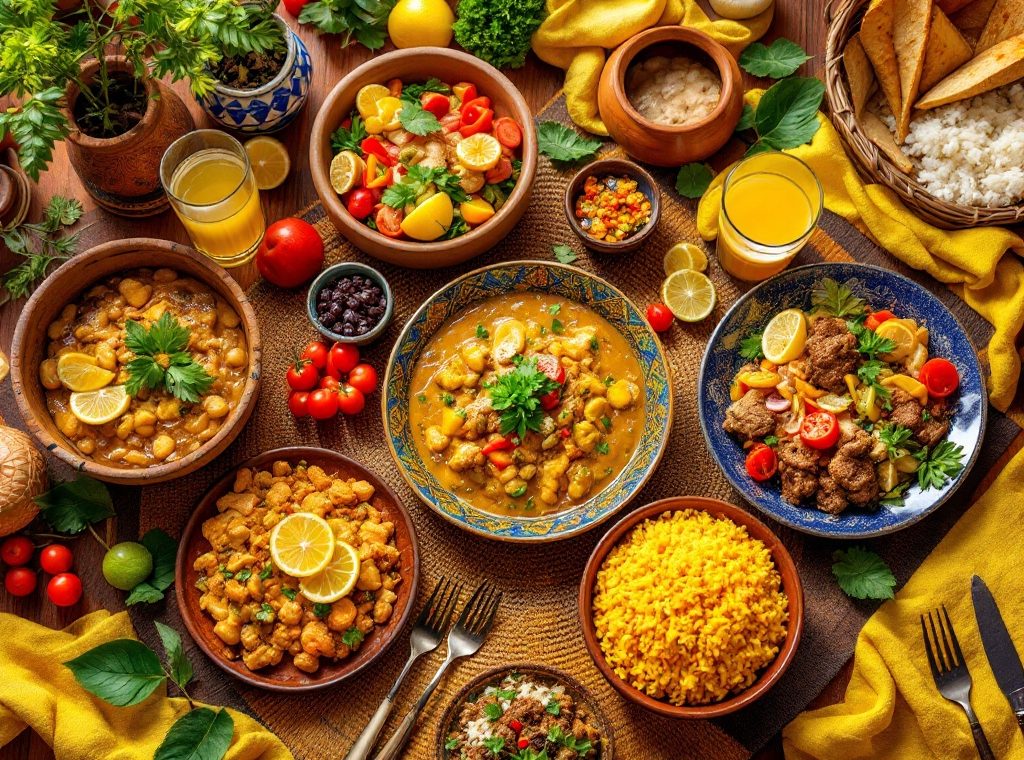Mali Traditional Food: The Best Local Meals You Can’t Miss
Embark on a culinary adventure to Mali, where rich flavors and communal dining traditions await. From the savory national dish, Tiguadege Na, a peanut butter stew, to the zesty Poulet Yassa, Malian cuisine features West African staples like millet, sorghum, and peanuts, blended with Arabic influences. Explore the diverse flavors of dishes like Maafe, a rich peanut stew, and Labadja, a simple yet satisfying beef and rice dish. Discover the unique desserts and traditional drinks like Djablani (ginger juice) and Bissap (hibiscus tea). Dive into this article and uncover the vibrant world of Malian food.
Important information

- Malian cuisine uses staples like rice, millet, and sorghum, often served with beef, lamb, chicken, or fish.
- Peanuts are a key ingredient, featuring in dishes like Tiguadege Na (the national dish, a peanut butter stew) and Maafe (a peanut-based stew).
- Communal dining is important in Malian culture.
- Popular drinks include Djablani (ginger juice) and Bissap (hibiscus tea).
- Arabic influences are present, adding spices like cumin and coriander to the mix.
Malian Cuisine: An Introduction to Local Flavors
Malian cuisine bursts with flavor, drawing inspiration from a variety of cultures. West African staples such as rice, millet, and sorghum feature prominently in many dishes, often complemented by beef, lamb, chicken, or fish. Communal dining is central to Malian food culture, where traditional cooking methods are still prized. Peanuts, tomatoes, onions, and leafy greens add depth and richness to the cuisine, making it a true celebration of both flavor and togetherness.
The Staple Ingredients of Malian Cuisine
Malian cuisine showcases a variety of grains, including millet, sorghum, rice, and fonio, which serve as the foundation for many dishes. Root vegetables like cassava, yams, and sweet potatoes are also prominent ingredients. Peanuts contribute a rich flavor to sauces and stews. The cuisine also incorporates fresh flavors from okra, tomatoes, onions, and spinach. Meat plays a significant role, with beef, mutton, chicken, goat, and fish providing protein. Finally, spices such as ginger, garlic, and chili peppers create bold and vibrant flavors.
Common West African Staples
Millet, sorghum, and rice are essential grains in Mali, often forming the base of flavorful sauces and stews. Root vegetables like cassava, yams, and sweet potatoes also play a crucial role. Peanuts, okra, tomatoes, and onions are dietary staples. Baobab leaves add a unique element to Malian cuisine, contributing to many traditional dishes.
Arabic Influences on Malian Ingredients
Malian cuisine is a delicious fusion of indigenous ingredients and Arabic culinary traditions. Spices like cumin, coriander, and cinnamon, staples of Arabic cooking, now enhance many Malian dishes. This influence extends to food preservation, as drying and smoking techniques common in Arabic cuisine are also prevalent in Mali. Yet, Mali retains its own distinct culinary identity. Local staples such as millet, sorghum, and peanuts contribute unique flavors. These ingredients, combined with Arabic techniques, create a rich and complex culinary experience. Picture, for instance, smoked meat infused with fragrant Arabic spices, a testament to this flavorful fusion.
Must-Try Traditional Dishes in Mali
Tiguadege Na, or peanut butter stew, is a hearty Malian staple combining meat (chicken, lamb, or beef) with a rich peanut sauce, vegetables like tomatoes, potatoes, and carrots, and flavorful spices. Enjoy it with rice or tô.
Poulet Yassa offers comforting Malian flavors with chicken marinated in a zesty lemon-onion sauce. The chicken is then grilled or pan-fried and served with rice and onions. Mustard, garlic, and other spices add depth to the marinade.
Couscous Timbuktu, a popular stewed couscous, features meat (beef, lamb, or chicken) and vegetables like carrots, potatoes, and onions, creating a flavorful, satisfying meal.
Maafe, a beloved West African stew also enjoyed in Mali, simmers meat (beef, chicken, or fish) in a peanut-based sauce with okra, tomatoes, eggplant, and spices. It’s often served with rice.
Labadja, a simple, traditional dish, combines stewed beef with onions, tomatoes, and spices served over rice. Dried fish or other vegetables can be added for variation.
Jollof rice, a West African favorite popular in Mali, is a one-pot dish cooked with tomatoes, onions, peppers, and spices. It is often accompanied by meat or fish.
Tiguadege Na: Mali’s National Dish
Tiguadege Na, Mali’s national dish, is a flavorful chicken stew featuring a rich peanut and tomato sauce. This hearty meal often includes vegetables like potatoes, carrots, onions, and garlic, and it’s typically served over rice. A true embodiment of Malian cuisine, Tiguadege Na showcases peanuts, a staple ingredient in West Africa.
Poulet Yassa: A Comforting Malian Dish
Poulet Yassa, a cherished Malian dish, features chicken marinated in a zesty onion-lemon-vinegar sauce. This marinade infuses the chicken with a tangy, savory flavor. It’s often served with rice, though couscous is another popular choice.
Couscous Timbuktu: A Popular Stewed Delight
Couscous Timbuktu, a classic Malian dish, combines steamed couscous with a rich stew. This stew often features chicken, lamb, or beef. This flavorful meal reflects North African influences, thanks to Timbuktu’s history as a major trade hub. It offers a delicious taste of the past.
Maafe: Spicy Peanut Stew
Maafe, a rich peanut stew, is a West African staple and showcases Mali’s culinary use of peanuts. Similar dishes, such as Tiguadege Na, also highlight this ingredient.
Labadja: Simple Beef and Rice Dish
Labadja, a simple yet flavorful Malian dish, combines beef and rice with dates and ras el hanout for a delightful sweet and savory experience. Chopped chuck steak is browned in butter, then simmered with onions, garlic, and aromatic spices. Soaked dates add a touch of sweetness as the rice cooks alongside these ingredients, creating a harmonious blend of flavors. Popular throughout Mali, Labadja is especially beloved in the north, where it’s known as Alabadja, and often enjoyed during Eid celebrations. This comforting meal offers a unique and satisfying taste of Malian cuisine.
Jollof Rice: A Popular African Dish
Jollof Rice, also known as Kwankwan in Mali, is a beloved celebratory dish across West Africa. This one-pot meal combines rice with fish or grilled chicken and a medley of vegetables. The Malian version often includes succulent grilled chicken or fish, giving the dish a unique flavor. The preparation starts by sautéing onions, garlic, and tomatoes to create a flavorful base. Spices are then added, infusing the rice with aromatic flavors as it simmers with the chicken or fish. The result is a satisfying and delicious meal, perfect for any festive occasion.
Exploring Malian Desserts
Malian cuisine often ends with fresh fruit or tea, highlighting a cultural preference for light, natural flavors after savory meals. Although desserts are not a prominent feature, treats like Bouille and Degué (also known as Thiacry) offer a taste of Malian culinary traditions.
Bouille: Traditional Malian Dessert
Bouille, a traditional Malian dessert, offers a sweet taste of the country, distinct from its savory cuisine. Made from millet or sorghum, this treat provides a uniquely Malian finish to a meal, unlike the more common fruit or tea. While savory dishes like Tiguadege Na and Jollof rice showcase one side of Malian cuisine, Bouille represents its sweeter culinary traditions.
Degué / Thiacry: A Sweet Treat
Degué, also known as thiacry, is a sweet Malian dessert made from fermented millet. This refreshing treat offers a unique and distinctly Malian way to conclude a meal, contrasting with more common choices like fruit or tea. It provides a true taste of Mali’s rich culinary heritage.
Traditional Malian Drinks You Must Try
In Mali, traditional drinks are essential to the dining experience, adding unique flavors and cultural depth. Popular choices include:
- Djablani, a zesty ginger beverage.
- Bissap, a refreshing hibiscus tea.
Often served with communal meals, where diners share food from a common bowl, these drinks enhance the shared experience and reflect the importance of community in Malian culture.
Djablani: Malian Ginger Juice
Djablani, a cherished Malian beverage, is also known as Malian ginger juice. This invigorating drink blends the zesty bite of ginger with lemon and mint, all complemented by water. Often enjoyed after meals, Djablani is readily available from street vendors throughout Mali.
Bissap: Hibiscus Tea
Mali’s beloved bissap, a vibrant red drink made from hibiscus flowers, offers a refreshingly sweet and tart flavor. This striking beverage is a popular way to cool down in the Malian heat.















